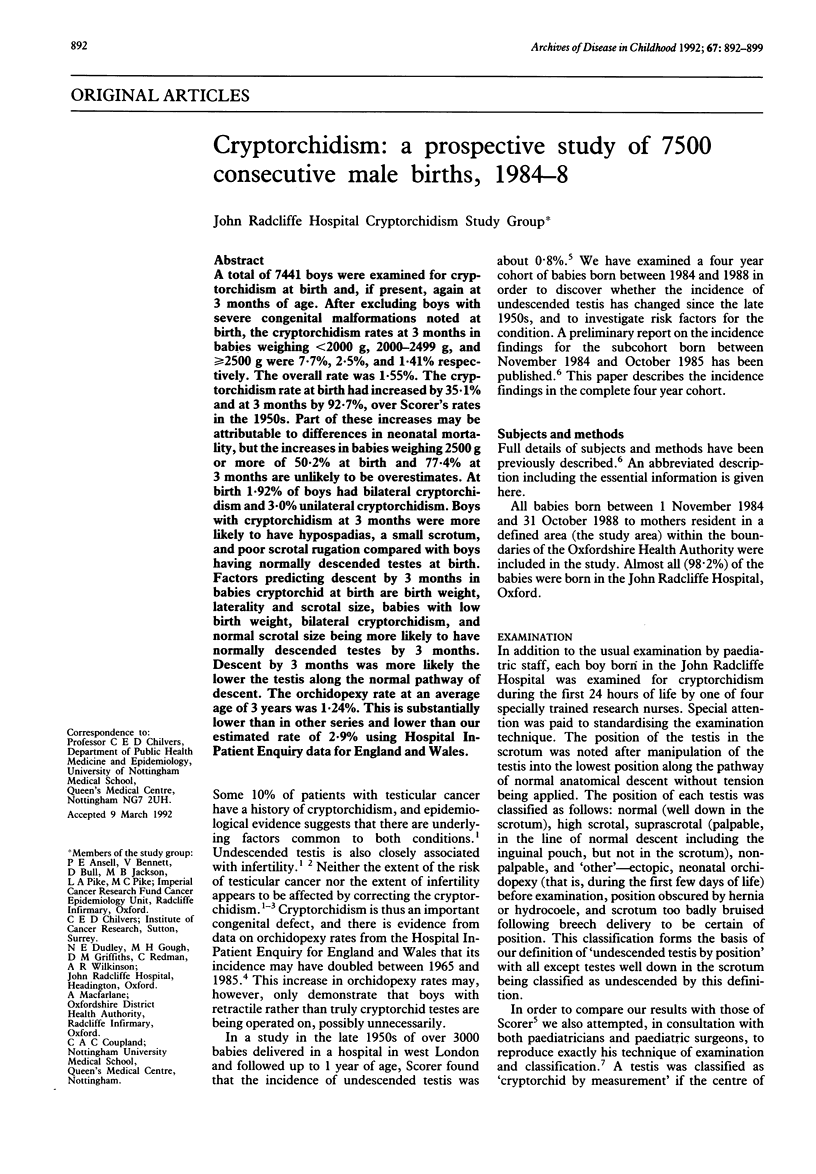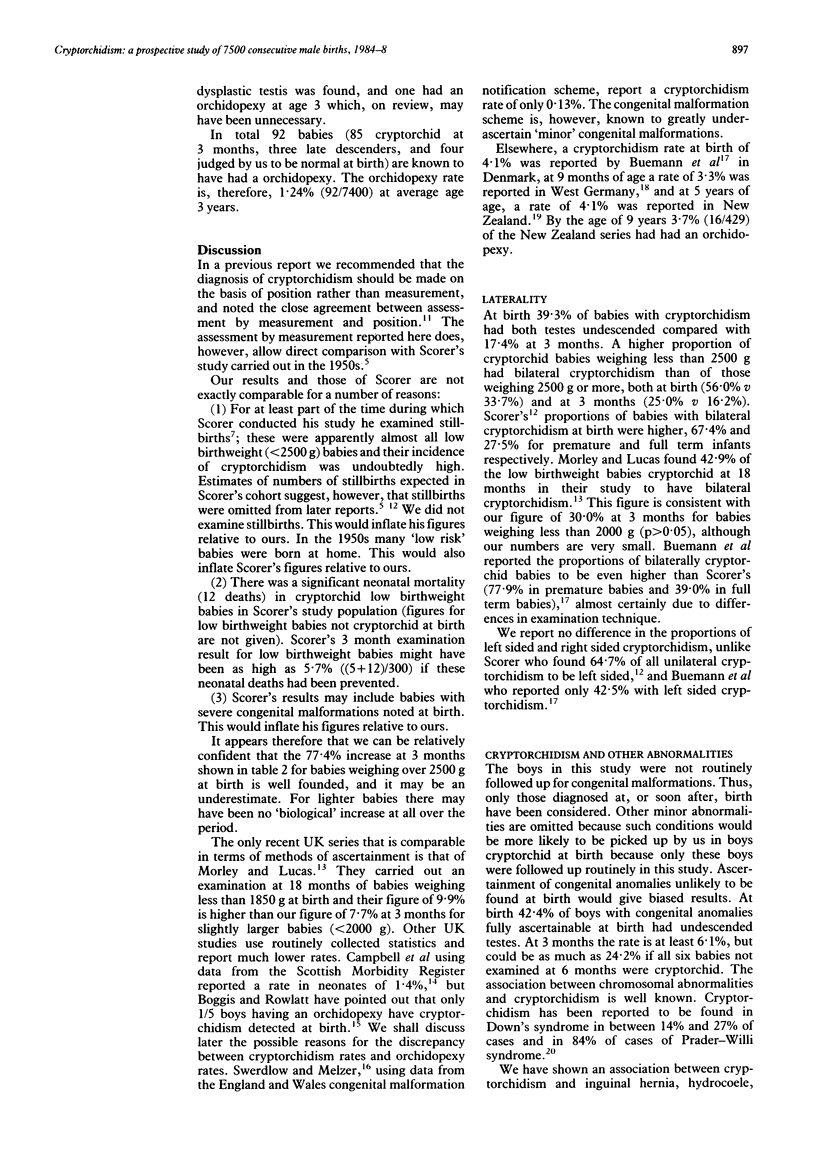Abstract
A total of 7441 boys were examined for cryptorchidism at birth and, if present, again at 3 months of age. After excluding boys with severe congenital malformations noted at birth, the cryptorchidism rates at 3 months in babies weighing less than 2000 g, 2000-2499 g, and greater than or equal to 2500 g were 7.7%, 2.5%, and 1.41% respectively. The overall rate was 1.55%. The cryptorchidism rate at birth had increased by 35.1% and at 3 months by 92.7%, over Scorer's rates in the 1950s. Part of these increases may be attributable to differences in neonatal mortality, but the increases in babies weighing 2500 g or more of 50.2% at birth and 77.4% at 3 months are unlikely to be overestimates. At birth 1.92% of boys had bilateral cryptorchidism and 3.0% unilateral cryptorchidism. Boys with cryptorchidism at 3 months were more likely to have hypospadias, a small scrotum, and poor scrotal rugation compared with boys having normally descended testes at birth. Factors predicting descent by 3 months in babies cryptorchid at birth are birth weight, laterality and scrotal size, babies with low birth weight, bilateral cryptorchidism, and normal scrotal size being more likely to have normally descended testes by 3 months. Descent by 3 months was more likely the lower the testis along the normal pathway of descent. The orchidopexy rate at an average age of 3 years was 1.24%. This is substantially lower than in other series and lower than our estimated rate of 2.9% using Hospital In-Patient Enquiry data for England and Wales.
Full text
PDF







Selected References
These references are in PubMed. This may not be the complete list of references from this article.
- Atwell J. D. Ascent of the testis: fact or fiction. Br J Urol. 1985 Aug;57(4):474–477. doi: 10.1111/j.1464-410x.1985.tb06315.x. [DOI] [PubMed] [Google Scholar]
- BUEMANN B., HENRIKSEN H., VILLUMSEN A. L., WESTH A., ZACHAU-CHRISTIANSEN B. Incidence of undescended testis in the newborn. Acta Chir Scand Suppl. 1961;Suppl 283:289–293. [PubMed] [Google Scholar]
- Boggis A. R., Rowlatt R. J. A study of the sources of delay in the diagnosis and treatment of undescended testicle. J R Coll Gen Pract. 1984 Aug;34(265):440–441. [PMC free article] [PubMed] [Google Scholar]
- Campbell D. M., Webb J. A., Hargreave T. B. Cryptorchidism in Scotland. Br Med J (Clin Res Ed) 1987 Nov 14;295(6608):1235–1236. doi: 10.1136/bmj.295.6608.1235. [DOI] [PMC free article] [PubMed] [Google Scholar]
- Chilvers C., Dudley N. E., Gough M. H., Jackson M. B., Pike M. C. Undescended testis: the effect of treatment on subsequent risk of subfertility and malignancy. J Pediatr Surg. 1986 Aug;21(8):691–696. doi: 10.1016/s0022-3468(86)80389-x. [DOI] [PubMed] [Google Scholar]
- Chilvers C., Pike M. C., Forman D., Fogelman K., Wadsworth M. E. Apparent doubling of frequency of undescended testis in England and Wales in 1962-81. Lancet. 1984 Aug 11;2(8398):330–332. doi: 10.1016/s0140-6736(84)92697-7. [DOI] [PubMed] [Google Scholar]
- Cooper B. J., Little T. M. Orchidopexy: theory and practice. Br Med J (Clin Res Ed) 1985 Sep 14;291(6497):706–707. doi: 10.1136/bmj.291.6497.706-a. [DOI] [PMC free article] [PubMed] [Google Scholar]
- Gendrel D., Job J. C., Roger M. Reduced post-natal rise of testosterone in plasma of cryptorchid infants. Acta Endocrinol (Copenh) 1978 Oct;89(2):372–378. doi: 10.1530/acta.0.0890372. [DOI] [PubMed] [Google Scholar]
- Heath A. L., Man D. W., Eckstein H. B. Epididymal abnormalities associated with maldescent of the testis. J Pediatr Surg. 1984 Feb;19(1):47–49. doi: 10.1016/s0022-3468(84)80014-7. [DOI] [PubMed] [Google Scholar]
- Hjertkvist M., Damber J. E., Bergh A. Cryptorchidism: a registry based study in Sweden on some factors of possible aetiological importance. J Epidemiol Community Health. 1989 Dec;43(4):324–329. doi: 10.1136/jech.43.4.324. [DOI] [PMC free article] [PubMed] [Google Scholar]
- Jackson M. B., Gough M. H., Dudley N. E. Anatomical findings at orchiopexy. Br J Urol. 1987 Jun;59(6):568–571. doi: 10.1111/j.1464-410x.1987.tb04879.x. [DOI] [PubMed] [Google Scholar]
- Jackson M. B., Swerdlow A. J. Seasonal variations in cryptorchidism. J Epidemiol Community Health. 1986 Sep;40(3):210–213. doi: 10.1136/jech.40.3.210. [DOI] [PMC free article] [PubMed] [Google Scholar]
- Mau G., Schnakenburg K. Maldescent of the testes--an epidemiological study. Eur J Pediatr. 1977 Aug 23;126(1-2):77–84. doi: 10.1007/BF00443125. [DOI] [PubMed] [Google Scholar]
- Morley R., Lucas A. Undescended testes in low birthweight infants. Br Med J (Clin Res Ed) 1987 Sep 26;295(6601):753–753. doi: 10.1136/bmj.295.6601.753. [DOI] [PMC free article] [PubMed] [Google Scholar]
- Pike M. C. Boys with late descending testes. Br Med J (Clin Res Ed) 1986 Nov 15;293(6557):1307–1308. doi: 10.1136/bmj.293.6557.1307-c. [DOI] [PMC free article] [PubMed] [Google Scholar]
- Pike M. C., Chilvers C., Peckham M. J. Effect of age at orchidopexy on risk of testicular cancer. Lancet. 1986 May 31;1(8492):1246–1248. doi: 10.1016/s0140-6736(86)91389-9. [DOI] [PubMed] [Google Scholar]
- SCORER C. G. THE DESCENT OF THE TESTIS. Arch Dis Child. 1964 Dec;39:605–609. doi: 10.1136/adc.39.208.605. [DOI] [PMC free article] [PubMed] [Google Scholar]
- SCORER C. G. The incidence of incomplete descent of the testicle at birth. Arch Dis Child. 1956 Jun;31(157):198–202. doi: 10.1136/adc.31.157.198. [DOI] [PMC free article] [PubMed] [Google Scholar]
- Simpson A. S., Laugesen M., Silva P. A., Stewart C., Walton J. The prevalence of retained testes in Dunedin. N Z Med J. 1985 Sep 11;98(786):758–760. [PubMed] [Google Scholar]
- Swerdlow A. J., Melzer D. The value of England and Wales congenital malformation notification scheme data for epidemiology: male genital tract malformations. J Epidemiol Community Health. 1988 Mar;42(1):8–13. doi: 10.1136/jech.42.1.8. [DOI] [PMC free article] [PubMed] [Google Scholar]
- Walter S. D., Elwood J. M. A test for seasonality of events with a variable population at risk. Br J Prev Soc Med. 1975 Mar;29(1):18–21. doi: 10.1136/jech.29.1.18. [DOI] [PMC free article] [PubMed] [Google Scholar]


